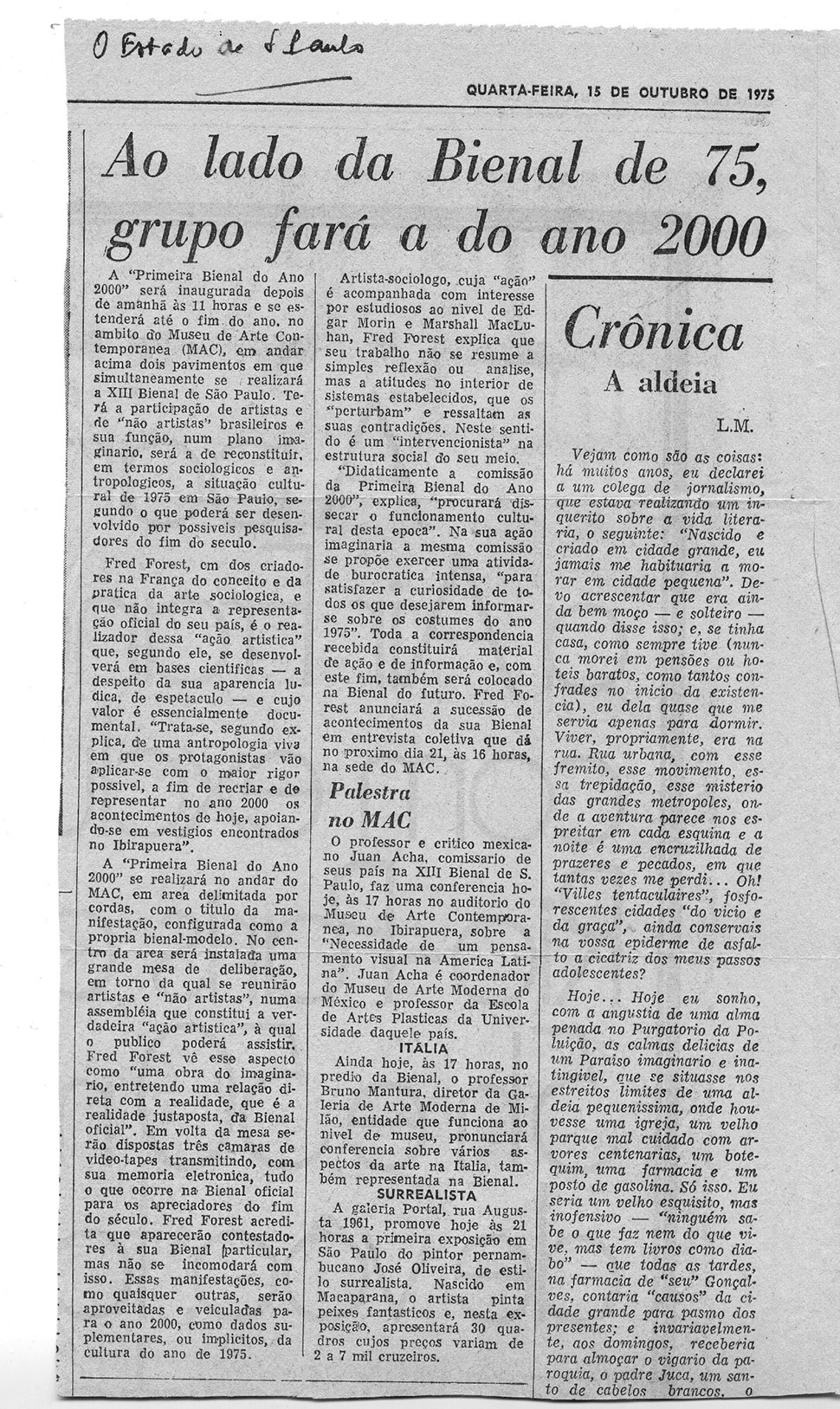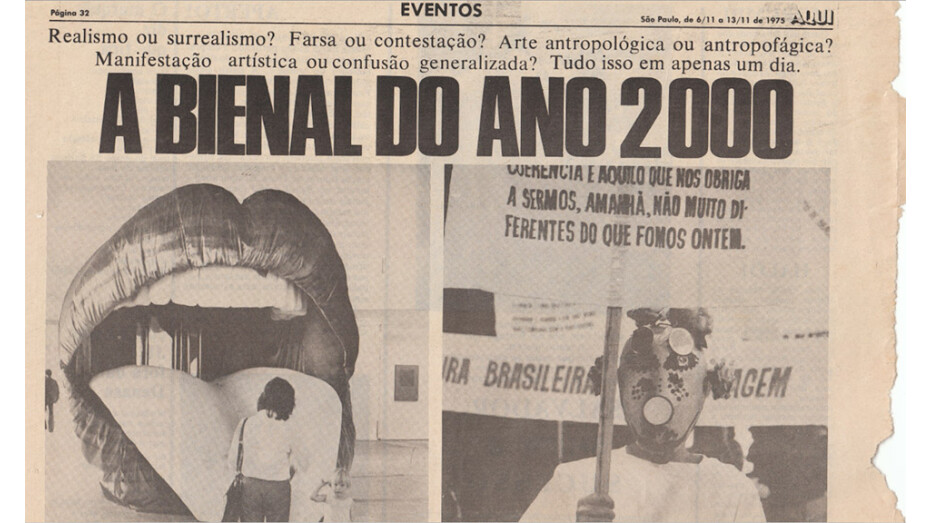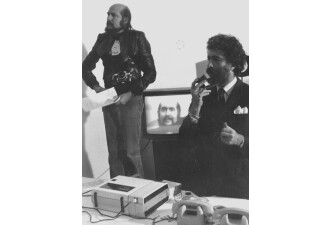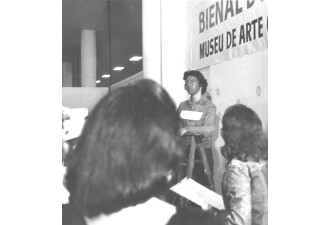Biennale des années 2000 à São Paulo
Right from the opening of his 2000 Biennial, Fred Forest struck a blow with the first day, which he devoted to women artists. Once again, he plays on the "distancing" of time to make sense.
BIENNALE 2000
Right from the opening of his 2000 Biennial, Fred Forest struck a blow with the first day, which he devoted to women artists. Once again, he plays on the "distancing" of time to make sense.
Let's not lose sight of the fact that we are in 1975, some fifty years ago...
Forest, always ahead of his time and his contemporaries, inaugurated what has become a kind of leitmotif in social networking in our time. But the women were already there to support him, including Amélia Tolédo, the leading Brazilian artist pictured here in the front row, a feminist before her time, accompanied by Anesia Pacheco Chaves, Régina Vater and Radah Abramo, as well as Walter Zanini, who as Director of the MAC did not hesitate to take enormous risks by making his museum's infrastructure available to him, so that he could mount his action. An eminently subversive action in the worst days of the military regime.
Forest, with his innate sense of communication, brought the venue to life with a team of a dozen dissident artists who set about breaking down the wide-open communication barriers between the official Biennial of 1975 and his own imaginary Biennial taking place in the year 2000...
Each of the artists improvised performances in an ironic and subversive mode. Forest, camera in hand, crosses the symbolic door to leave the Year 2000 that he presides over for a moment and travels to 1975, where he conducts a number of interviews, including those with Jack Bolton, the young curator who accompanies the American artists and who promises him a visit to his Biennial of the Year 2000. He caught up with Jacques Lassaigne, the Biennial's life curator (at the time a French art grandee who headed up the Musée d'Art Moderne de la Ville de Paris...). Some time ago, during one of Parinaud's programmes, the "Forum des arts", he took him aside for a moment to tell him in a falsely paternal tone "that what he was doing with this technical tool called video would never achieve anything for art"! Forest took advantage of the opportunity to remind him of his prophecies, saying: "You see, Mr Lassaigne, this video with which I'm recording you will at least have brought me to you today... until I replace you as French commissioner very soon".
Without a word of reply, Lassaigne shrugged off the artist. Luckily a journalist from O Estado who happened to be passing by wrote in his paper as a scoop the next day: "Fred Forest nomeado futuro curador francês da Bienal, em substituição de Jaques Lassaigne" As I've always told you the media have never finished spoiling me throughout my life!" 😊
---------------------------------------------------
1975 BIENNALE 2000 pour la XIIème Biennale de Sao Paulo
Fred Forest's ability to find themes for his actions, which are based on an ever-renewed imagination, seems infinite. Here again he plays on his capacity for distancing and projecting into time, which allows him to decree that the Biennial he is proposing in relation to the official Biennial, which is taking place this year in 1975, is taking place in the year 2000, i.e. 25 years ahead of time. This distance of 25 years that he imposes on time allows him to imagine that in this time span many things will have disappeared, for example that in the best of cases the military regime will have given way to a profoundly democratic regime... And he invited some twenty dissident Brazilian artists who had refused to take part in the official Biennale of 1975 to take part in his utopian Biennale, which he intended to install in the official Biennale. As always, his desire for perfection led him to prepare his Biennial in Paris, down to the last detail, and to put himself in the shoes of the organisers, sending out flyers by post to museums and cultural operators all over the world, full of details, announcing the arrangements for his own Biennial for the year 2000, which would of course take place in 1975, starting and finishing on the same day as the official Biennial and in the same place.
In other words, in Ubirapuera Park, where the imposing hall built in Sao Paulo by Niemeyer is located.
At the outset, he announced all this without any plausibility, trusting in his gifts of ubiquity which, through a certain "magic" that he possesses as a natural gift, will make him stick to reality. He has indeed begun long-distance correspondence with Walter Zanini, the Director of the MAC at the University of Sao Paulo, whose Museum is housed in the same buildings that host the Biennial every two years. This detail did not escape the attention of our 'sociological artist', who also noticed that a large gate, always closed, separates the two venues. All it took was for it to be opened for the two spaces to become contiguous, and ultimately to merge for the public. This gave enormous credibility and official status to the Biennial of Protest created by Forest. It also benefited from the enormous publicity generated by the official Biennial, which served it by contiguity, and enabled Forest and his Brazilian accomplices to attract a huge audience.
But it is also necessary many other technical and financial means to ensure the operation of a Biennial... Forest knew it well, counting on his baraka to find them... During a meal at relations, one put to him the question in Paris to know if he would go this year in 1975 to the Biennial as it had been the case in 1973 where his media presence had left deep traces? He spoke of his lack of means. When a guest seated not far from him told him that she knew an advertising executive from a large pharmaceutical company in Sao Paulo who might be able to help him? At that very moment, thanks to his sense of divination, Forest realised that the magical process had begun... As he still had no answer from Zanini as to the occupation of the MAC by his Biennial 2000, he asked the person in charge, whose name this charming guest had thrown over the table, a certain Pierre Landolt. So he asked this gentleman for everything he needed, including a huge tent in which to set up his Biennial 2000 as close as possible to the Parc Ibirapuera, near the Neimeyer building, and of course a whole host of other things, including a van + several cameras + three assistants + ladders etc. etc. etc. etc. Forest's entire wish list was now fulfilled by this Mr Landolt, who had even added a blank cheque so that he could pay for his plane ticket without skimping on the price so as not to have to deal with the exchange problem. The magic had once again worked its magic for him, and it wasn't his former postal colleagues in Mascara who would have had anything to say about the situation, as they were still toiling away at the sorting table to ensure that the mail arrived on time... Oh, I almost forgot to tell you the most important thing: This Mr Pierre Landolt, Forest learned on the spot after three months that he was, in fact, the heir to the Swiss family that owns three banks in Europe and the second richest family in Europe... Check it out if you like, by doing a quick Google tour.
Right from the opening of his Biennale 2000, Fred Forest struck a blow with the first day he devoted to women artists. Let's not lose sight of the fact that this was 1975, so it's already fifty years or so since this adventure took place... Forest, always ahead of his time and his contemporaries, inaugurated what has become a sort of catchphrase in our time, something we're constantly hearing about without the general public yet being entirely convinced. Amélia Tolédo, the leading Brazilian artist pictured here in the front row, a feminist before her time, gave him decisive support, along with Anesia Pacheco Chaves, Régina Vater and Radah Abramo, as did Walter Zanini, who as Director of the MAC did not hesitate to take enormous risks by making his museum's infrastructure available to him, so that he could mount his eminently subversive action during the worst period of the military regime.
Forest, with his innate sense of communication, brought the museum to life with a team of a dozen dissident artists who set about breaking down the wide-open communication barriers between the official Biennial of 1975 and his own imaginary Biennial, which took place in the year 2000...
Each of the artists improvised performances in an ironic and subversive mode, including Anésia Pacheco Chaves organising an official reception dressed as a soubrette, the only food offered being whole bunches of bananas.
Or the enlarged photo of an official general at the opening of the exhibition, which was the subject of a sartorial analysis with the participation of the public, mockingly claiming that this was the chosen costume of artists in the year 2000... We would still have an enormous amount to tell you about the Biennale 2000, but we will resume tomorrow for fear of tiring you out...
---------------------------------------------------
Fred Forest's 2000 Biennial got off to a flying start with a tribute to women in... 1975
Copyright texts: Fred Forest/ADAGP
Fred Forest's artistic practice is often based on a fiction that he contrasts with reality. This is precisely the case with the Biennale de l'an 2000 that he set up in 1975 for the XIIIth Sao Paulo Biennale, to which he was naturally not invited after all he had done during the XIIth Biennale, which may have displeased people. But in any case, custom dictates that artists have to wait a certain number of years before being invited again...
But we know that Forest is a very special case who, by nature, escapes the norms... His idea to make up for his absence was to invent a Biennial to compete with the official twelfth Biennial of 1975 by juxtaposing it. On the strength of his many local contacts, contacts with the media and the complicity of Walter Zanini, Director of the Mac (Museum of Contemporary Art) in Sao Paulo, a number of artists and his own determination, he was determined to succeed. He began by sending out a few press releases to museums around the world, announcing the creation of his (fictitious) Biennial, which he called Biennial 2000, in contrast to the official Biennial, which took place in 1975. Still in Paris, he contacted a certain Pierre Landolt, who was said to be in charge of the advertising budget for a major pharmaceutical company... He wrote to him explaining what he wanted to do. And what a miracle! This providential man, who had heard about his actions, replied that he was ready to meet all his needs as soon as he arrived and, to top it all off, even added a blank cheque to his correspondence. A cheque that would enable him to pay for his trip from Paris when the time came, given the fluctuations in airline fares! A real fairy tale for our artist, who immediately got in touch with Zanini, whom he asked to arrange a meeting with dissident artists for his arrival.
After a long conversation with the artist, Zanini, being a man of courage, agreed to involve his Museum in the critical action proposed by the artist, and a few days later brought together dissident artists from the official Biennale to discuss the modalities and programming. In the photo you can see Rada from the front, Amelia to her right and Anesia Pacheco Chaves, Zanini and Fred Forest partly hidden.
Forest, with his innate sense of communication, brought the premises to life with a team of a dozen dissident artists who were working to break through the wide-open communication barriers between the official Biennial of 1975 and his own imaginary Biennial, which was taking place in the year 2000... The MAC's premises adjoined the hall in Oscar Niemeyer's building where the XIIIth Sao Paulo Biennial was taking place. It was an extraordinary opportunity for Fred Forest, since the door between the two venues remained permanently wide open, allowing visitors to move from 1975 to 2000 and back again, integrating his fictional Biennial with the official contingent reality under the same label.
Each of the dissident artists he presents improvises performances in an ironic and subversive mode, such as Anésia Pacheco Chaves organising an official reception dressed as a soubrette, and whose only food offered is whole bunches of bananas that she carries around in a wheelbarrow. Or this photo, enlarged on a wall, of an official junta general at the opening of the exhibition, the subject of a delirious sartorial analysis with the participation of the public, claiming in mockery for commentators in verve that this was the usual official costume chosen by artists in 1975... Each of us went our own way in analysing, describing and interpreting. As for Fred Forest, in the form of a mock press conference conducted with the utmost seriousness, he asked the audience to dig deep into their pockets, bags or wallets for evidence of the years 1975: bills, identity cards, parking tickets, etc. The whole thing was relayed by a circuitous circuit to the audience. The whole thing was broadcast on closed-circuit TV. Fred Forest asking the audience for objects referenced in the year 2000, which his assistants immediately put on an ad-hoc list.
Forest, with the help of his assistants, referencing the objects that the public very scrupulously handed over to him. Until the moment when an overweight person (no doubt a junta agent in civilian clothes) stood in front of him, smiling broadly, opened his jacket to reveal an enormous barrel pistol. Cautiously, he extracted a bullet and held it out to the artist... The latter grasped it between thumb and forefinger and pretended to read the references. A stunned silence fell over the room. With a look as satisfied and knowing as his owner, Forest pretended to scribble the reference alongside the other objects on his list, then handed the object of death back to the policeman in question and declared in a firm voice to the audience: "Yes, that's right, this object was called SUPPOSITORY in 1975!
The man with the barrel disappeared immediately, the room suddenly caught its breath, and Forest meticulously continued his inventory of the documents that the public had handed him.
---------------------------------------------------
Fred Forest, who had abandoned his portapack for a time, crossed the threshold of the open door to go from his 2000 biennial to the 1975 one, in order to conduct interviews with those in charge of the video, questioning them critically about the way it was organised and the undemocratic choices made by the artists. Here we see him wearing the BIENNIAL MENTION 2000 on his forehead as he interviews the official US curator Jack Bolton. Immediately afterwards, he interviews the French curator Jacques Lassaigne with the same verve. Lassaigne has been in control of this and many other police stations for years. Shortly before, meeting Forest in a TV programme on the Forum des arts, he had said to him in a paternalistic tone: "With your technological art, you won't get very far". On that occasion, the artist pointed out that his art had already taken him as far as Sao Paulo...
All these interviews, a precious harvest, will join the BIENNALE 2000 in return to be broadcast continuously on the big screen to the parodic verve of a public delighted to take part.



LONG BIOGRAPHY OF FRED FOREST
Fred Forest has a special place in contemporary art. Both by his personality and by his pioneering practices which mark his work. He is mainly known today for having used one by one most of the communication media that have appeared over the last fifty years. He is co-founder of three artistic movements: those of sociological art, the aesthetics of communication and ethics in art.
He represented France at the 12th São Paulo Biennale (Communication Prize) in 1973, at the 37th Venice Biennale in 1976 and at Documenta 6 in Kassel in 1977.
EXHIBITION AT THE CENTRE POMPIDOU FROM JANUARY 24 TO OCTOBER 14, 2024


















